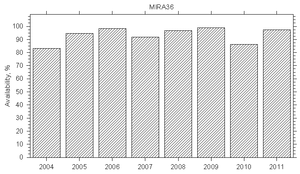Cloud radar operational use
Although, currently cloud radar data are not assimilated by Numerical Prediction Models (NWP) a continuous monitoring of the vertical cloud structure is very useful for evaluations of NWP and climat models, satellite validations, process studies and for enhanced cloud climatologies. One of the first unattended 35 GHz cloud-profiling radar, the MMCR, was designed in the frame of the ARM-program (Moran et al., 1998) and is actually used at five ARM stations. In Europe a joint activity started with the Cloudnet project where at three sites (in the inital stage) cloud radars have been operated to derive cloud parameters for model evaluations (Illingworth et al. (2007)). Cloud products as well as NWP evaluation results from several sites and for different models are available on the cloudnet web page. For deducing cloud products as for example liquid or ice water content or effective radius different methods are suggested in literature (Turner et al., 2007, Comstock et al., 2007). Beside the cloud radar as key instrument, laser ceilometer and microwave radiometer are valuable additions.
The Cloudnet activities will be extended to further European stations in the EU-project ACTRIS, which started in 2011. Approximately eight stations equipped at least with a cloud radar, a ceilometer and a radiometer will have the capability to make continuous quality controlled observations of clouds and additional of aerosols. Data will have quantified error characteristics and will be available in near real time.
Cloudnet data were used for example by Hogan et al. (2001), Hogan et al. (2009) who verified model derived cloud fraction forecasts with radar derived values or by Morcrette et al. (2012).
Nowadays, the reliability of cloud radars is sufficient for an operational usage as the following figure shows.
Back to Cloud radar
